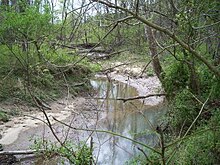Dix, Illinois

Dix is a village in Jefferson County, Illinois, United States. The population was 494 at the 2000 census. It is part of the Mount Vernon Micropolitan Statistical Area.
Geography
Dix is located at 38°26′26″N 88°56′33″W / 38.44056°N 88.94250°W (38.440676, -88.942463).[1]
According to the 2010 census, Dix has a total area of 2.1 square miles (5.44 km2), of which 2.09 square miles (5.41 km2) (or 99.52%) is land and 0.01 square miles (0.03 km2) (or 0.48%) is water.[2]
Dix is located on high ground that marks the boundary between the Big Muddy River and its tributary, Casey Creek.
Today Dix is an exit on Interstate 57, a major north/south roadway. When it was founded, however, it was on the Goshen Road, which was the main east/west road in Illinois, running from Old Shawneetown, Illinois to near East St. Louis, Illinois.
History
Among the first settlers around Dix were two brothers named Andrews (Arba and Nelson?), who came from Rome, New York, around 1830. One of them established a post office called "Jordan's Prairie", the name already given to the grassland to the south. Later he platted out a village, which he called "Rome", after his home town in New York. The post office was moved into the village in 1852, and the name changed.
Hiram Milburn of Kell, Illinois moved to Rome between 1853 and 1855. Milburn built a storehouse in 1853 and a hotel in 1854. It is said that, during the construction of the hotel, a wind blew the structure down into a pile, while two men were on the joists, but nobody was hurt. In 1855 Milburn purchased Leuty's Mill and moved it to Rome.
Although Rome Township still exists, the name of the town was changed to "Dix" when the village was incorporated in 1869. There was and still is another Rome, Illinois and the Post Office insisted that the name of this village be changed.[citation needed]
There are several stories as to the origin of the name "Dix". One is that the town was renamed in honor of Gen. John Adams Dix. At the outbreak of the Civil War, Gen. Dix sent a telegram to his agents in New Orleans stating: "If any man pulls down the American flag, shoot him on the spot". Although the telegram was intercepted by Confederate agents and never reached its intended recipient, the text reached the press, and Gen. Dix became one of the first heroes in the North.
Dix is served by the Norfolk Southern Railway. This was built around 1890. The rail line comes from the St. Louis area and turns southeast at Dix. It follows the west side of Casey Creek down to Mt. Vernon.
Demographics
| Census | Pop. | Note | %± |
|---|---|---|---|
| 1880 | 153 | — | |
| 1890 | 186 | 21.6% | |
| 1900 | 229 | 23.1% | |
| 1910 | 233 | 1.7% | |
| 1920 | 216 | −7.3% | |
| 1930 | 189 | −12.5% | |
| 1940 | 246 | 30.2% | |
| 1950 | 190 | −22.8% | |
| 1960 | 181 | −4.7% | |
| 1970 | 167 | −7.7% | |
| 1980 | 319 | 91.0% | |
| 1990 | 456 | 42.9% | |
| 2000 | 494 | 8.3% | |
| 2010 | 461 | −6.7% | |
| 2015 (est.) | 457 | [3] | −0.9% |
As of the census[5] of 2000, there were 494 people, 274 households, and 116 families residing in the village. The population density was 235.9 people per square mile (91.3/km²). There were 287 housing units at an average density of 137.0 per square mile (53.0/km²). The racial makeup of the village was 98.38% White, 0.20% African American, 0.81% Asian, 0.20% from other races, and 0.40% from two or more races. Hispanic or Latino of any race were 0.40% of the population.
There were 274 households out of which 16.8% had children under the age of 18 living with them, 34.3% were married couples living together, 6.2% had a female householder with no husband present, and 57.3% were non-families. 54.7% of all households were made up of individuals and 36.1% had someone living alone who was 65 years of age or older. The average household size was 1.80 and the average family size was 2.73.
In the village the population was spread out with 18.4% under the age of 18, 4.9% from 18 to 24, 20.4% from 25 to 44, 24.1% from 45 to 64, and 32.2% who were 65 years of age or older. The median age was 50 years. For every 100 females there were 77.7 males. For every 100 females age 18 and over, there were 69.3 males.
The median income for a household in the village was $12,222, and the median income for a family was $37,321. Males had a median income of $28,000 versus $19,306 for females. The per capita income for the village was $12,463. About 10.6% of families and 22.0% of the population were below the poverty line, including 9.7% of those under age 18 and 29.5% of those age 65 or over.
Notable people
- George Corbett, running back for Chicago Bears 1932-38
- Keith Stroup, activist, founder of NORML[6]
References
- ^ "US Gazetteer files: 2010, 2000, and 1990". United States Census Bureau. 2011-02-12. Retrieved 2011-04-23.
- ^ "G001 - Geographic Identifiers - 2010 Census Summary File 1". United States Census Bureau. Retrieved 2015-08-02.
- ^ "Annual Estimates of the Resident Population for Incorporated Places: April 1, 2010 to July 1, 2015". Retrieved July 2, 2016.
- ^ "Census of Population and Housing". Census.gov. Retrieved June 4, 2015.
- ^ "American FactFinder". United States Census Bureau. Retrieved 2008-01-31.
- ^ Newton, David E. (2013). Marijuana: A Reference Handbook.

